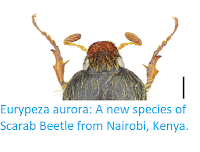Wedge-shaped Beetles, Ripiphoridae, are a small but widely distributed family of Beetles related to Blister and Fungus Beetles. They are unusual
in that they are parasitoids, with their larvae developing inside the
body of another Insect and only emerging as an adult (typically with
fatal consequences for the host), typically targeting Cockroaches, Bees
or Wasps (including Wasp species that are themselves parasitoids).
Wedge-shaped Beetles lack the penetrating ovipositors (egg laying
organs) of parasitoid Wasps, instead laying their eggs on a host or in
places where the emergent larvae will encounter a suitable host, for
example some Bee-targeting species lay their eggs on flowers, with the
newly hatched larvae climbing onto the back of visiting Bees, then
hitching a ride back to the hive where they infects larval Bees in their
cells. The group is generally split into five subfamilies, with the Pelecotominae interpreted as the oldest and most primitive of these, forming the sister group to the other subfamilies. The fossil record (although sparse for Wedge-shaped Beetles as a whole) appears to support this, with the oldest known fossil member of the group, from the Middle Jurassic Daohugou Biota, being placed in the Pelecotominae.
In a paper published in the journal Cretaceous Research on 25 October 2017, Yun Hsiao of the Department of Entomology at the National Taiwan University, and Chia-Lung Huang of the Department of Life Sciences at the National Taiwan Normal University, describe a new species of Plecotomine Wedge-shaped Beetle from Late Cretaceous Burmese Amber.
Middle Cretaceous ‘Burmese Amber’ has been extensively worked at several
sites across northern Myanmar (though mostly in Kachin State) in the
last 20 years. The amber is fairly clear, and often found in large
chunks, providing an exceptional window into the Middle Cretaceous
Insect fauna. This amber is thought to have started out as the resin of a
Coniferous Tree, possibly a Cypress or an Araucaria, growing in a moist
tropical forest. This amber has been dated to between 105 and 95
million years old, based upon pollen inclusions, and to about 98.8
million years by uranium/lead dating of ash inclusions in the amber.
The new species is named Spinotoma ruicheni, where 'Spinotoma' is a combination of 'spiney' and 'Pelecotoma', the modern genus from which the subfamilly Pelecotominae derives its name, and 'ruicheni' honours Rui Chen of the Institute of Zoology of the Chinese Academy of Sciences, who donated the specimen from which the species is described to the Century Amber Museum in Shenzhen.The species is described from a single female specimen 6.5 mm in length, with an elongate head with large oval eyes and long legs.
Spinotoma ruicheni in right lateral view. Scale bar is 1 mm. Hsiao & Huang (2017).
See also...
Follow Sciency Thoughts on Facebook.







